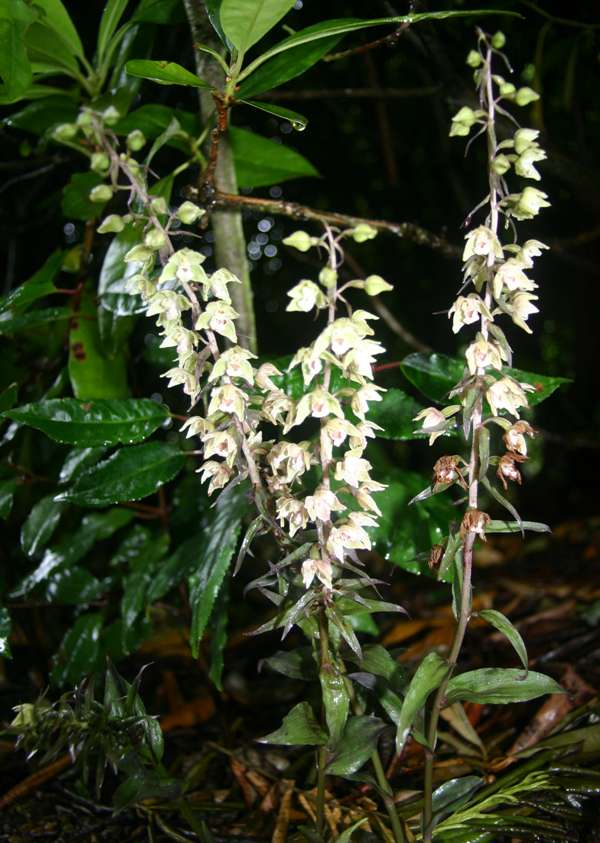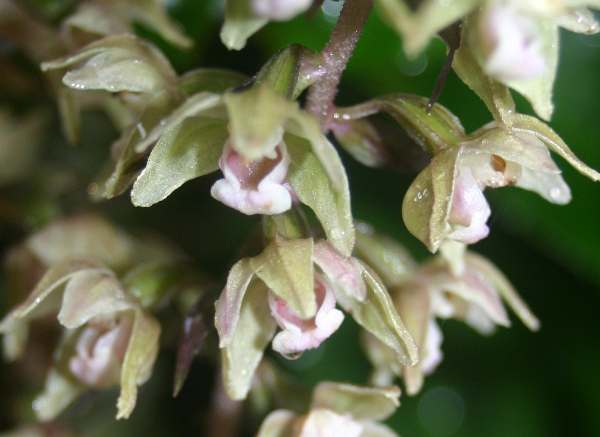Epipactis purpurata - Violet Helleborine
Phylum: Magnoliophyta - Class: Liliopsida - Order: Orchidales - Family: Orchidaceae

Epipactis purpurata is rare and localised and frequently grows with Epipactis purpurata var. rosea, an even rarer plant which has no chlorophyll and is entirely dependent on a relationship with mycorrhizal fungi for its survival.
Description
Growing to around 40 cm typically, the Violet Helleborine can grow much taller - to around a metre in height. With the exception of Epipactis purpurata var. rosea this is the most noticeable of the helleborines because of the large, pale flowers which open fully allowing cross pollination by insects.
The plants have quite broad leaves which are washed purple on their undersides. There are further narrower bracts throughout the inflorescence.
The relatively large flowers are pale green with white lips which surround a pinkish hypochile.
Distribution
The Violet Helleborine can be found throughout the southern part of England and in the temperate zone of west and centralEurope.
Habitat
It grows in shaded woodlands (especially Beech) and sometimes in conifer plantations. It likes deep, slightly moist soils.

The specimens shown on this page were seen in Surrey in July.
Flowering times
The Violet Helleborine flowers from mid-July and well into August.
Varieties and Hybrids
Varieties:
Epipactis purpurata var. rosea is a beautiful plant which lacks chlorophyll and is rose pink with whitish flowers.
Hybrids:
Epipactis purpurata x schulzei, a hybrid with Broad-leaved Helleborine Epipactis helleborine, is frequently reported.
Etymology
The genus name Epipactis is an ancient Greek name of a plant said to be capable of curdling milk (perhaps a Hellebore). The type species of this genus is Epipactis helleborine, the species name of which means 'like a hellebore' - a reference to a physical resemblance in this instance. The specific epithet purpurata means 'purplish'.
Reference sources
The Plant List
Sue Parker (2023) Wild Orchids of Wales - how, when and where to find them; First Nature e-book (Amazon Kindle format)
Anne and Simon Harrap (2005) Orchids of Britain and Ireland; A&C Black
Pierre Delforge (2005) Orchids of Europe, North Africa and the Middle East; A&C Black
Den Nordiska Floran (1992) Bo Mossberg, Stefan Ericsson and Lennart Stenberg; Wahlstrom & Widstrand
Please Help Us: If you have found this information interesting and useful, please consider helping to keep First Nature online by making a small donation towards the web hosting and internet costs.
Any donations over and above the essential running costs will help support the conservation work of Plantlife, the Rivers Trust and charitable botanic gardens - as do author royalties and publisher proceeds from books by Pat and Sue.


